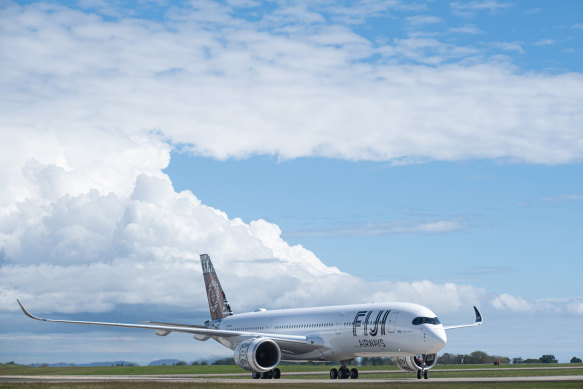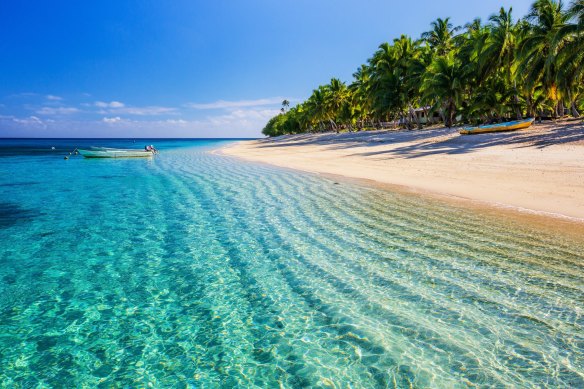Airline now bigger than before COVID as Aussies flock to Pacific paradise
The Fiji Airways hangar at Nadi Airport is usually busy with mechanics and engineers but on Tuesday, August 15, it’s hosting a milestone event for the national carrier. At the front of an audience of more than 2000, a conga line of women sways to and fro to the sound of island rhythms blasted over a PA system that fills the cavernous space. There’s an MC on the stage and the giant video screen shows an aircraft approaching.

Fiji Airway’s newest Airbus A350 arrives at Nadi Airport earlier this month.
It’s an Airbus A350-900XWB, the latest acquisition for Fiji Airways. The camera follows the aircraft as it touches down and slowly makes it way to the front of the hangar. Just before it rolls to a stop it’s baptised with twin arcs of water spurting from fire engines on either side. Stairs roll into position, the door opens and Prime Minister Sitiveni Rabuka, the CEO and chairman of the airline and several ministers march down and onto a stage.
Speeches are made, there’s a rousing performance by a cohort of over a hundred boys from the Queen Victoria School, established to provide education for the sons of Fijian chiefs, where Rabuka himself was once head boy. Finally, we’re allowed onboard, following hot on the heels of Rabuka as he makes a circuit of the aircraft.
This is Fiji Airways’ third A350. Another is expected to arrive before the end of August. Within the space of two weeks the airline will have doubled its A350 fleet. That’s a big call for any airline, and a huge vote of confidence, symptomatic of the rapid recovery of the island-nation’s tourism industry.
Fiji took a big hit during the pandemic. Medical containment zones were established on Viti Levu, the main island, restricting travel. A curfew was imposed and inter-island travel forbidden. Workers who were marooned on island resorts had to stay put, in some cases within sight of their families on neighbouring islands. International travel shut down. Although Fiji had fewer cases of COVID-19 and deaths relative to its population than Australia, authorities were terrified that if the infection spread on outer islands it would cripple Fiji’s medical system.
Fiji re-opened to visitors on December 1, 2021. “Once borders re-opened we had anticipated a very slow ramp up to 2019 levels that would take at least 18 months,” according to Andre Viljoen, Fiji Airways’ chief executive. “During the shutdown we put in place a readiness strategy that covered all areas of our operations and that really paid off. We were the first movers when borders opened in Australia and the USA and that aligned with the eagerness of our former clients and within the expatriate community to return to Fiji. Within six months we reached the pre-COVID passenger numbers experienced in 2019.”

Sun, sand and welcoming locals have been the key to Fiji’s post-COVID comeback.Credit: iStock
The future looks bright, according to Viljoen. The carrier’s bookings to July 2024 are 35 per cent ahead of 2019 levels. Leading the charge, Australia and New Zealand are both up by 47 per cent while the USA is ahead by 22 per cent. Fiji is also one of the few international destinations where more Australians are now visiting than before the pandemic.
New routes have been added to the airline’s network – Vancouver in November 2022 and since July 21, 2023, Canberra. Fiji Airways is the only carrier operating international flights into our national capital.
That increased demand drove the need for new aircraft. At the mid-August launch Viljoen ticked the reasons the A350 is the right fit for Fiji Airways’ medium and long-haul flights, including its 15 to 20 per cent reduction in fuel burn and operating costs, its range of 15,000 km with a full load of 334 passengers, the quietest cabin of any twin aisle aircraft and 20 per cent less CO2 emissions.
“The arrival of the fourth A350 will add another 60 seats per flight over the airline’s current A330–200,” says Viljoen. “That will add 50,000 more seats on average per month.” As a result of the new acquisitions, as of August 2023 Fiji Airways’ network is 31 per cent bigger than in 2019. By December 2023 that figure is forecast to be 40 per cent.
Fiji Airways lives or dies on the strength of the country’s tourism industry. The airline carries almost 70 per cent of all visitor arrivals and the tourism industry is booming. “We are about 12 months ahead of schedule in our tourism industry recovery,” according to Brent Hill, chief executive of Tourism Fiji.
“As well as more tourists, the average spend per visitor is up, now about $F3500 ($2420). That success is largely due to the preparations we made during the pandemic. In its aftermath airlines were struggling with bags being lost, there was carnage in European airports and all that craziness played well for us. We worked hard to ensure a smooth visitor experience, and then of course there’s the natural Fijian happiness that comes through. All of those combine to deliver a holiday experience that people are looking for right now.”
The boom in tourist numbers has also caused a few problems. Flights that arrive simultaneously at Nadi International Airport are causing a bottleneck at immigration processing.
“There’s a lot of work to be done at the airport,” says Viljoen. “Viliame Gavoka, the minister responsible, is across all the details and they’ve just appointed a new CEO with the priority to sort out transit and just generally enhance the facilities for what we call below the wing services.”
There is also a scarcity of hotel rooms. Resorts are reporting close to 100 per cent occupancy, in mid-August, well outside school holiday periods when demand peaks.
“We’re starting to see a construction boom happening in Fiji to address that,” says Hill. “I don’t think we’ll continue to witness the spectacular year-on-year growth we’re seeing right now but we want to maintain the current level until we have new accommodation that can soak up the extra demand. What it means for Fiji is incredible. You can see and feel the buzz.”
Hill isn’t shy when asked why tourists have been so quick to return. “It’s the sun, the sand, the islands and the beautiful environment, and of course the Fijian people are the real trump card, just the warmth and the friendliness that the Fijians extend to visitors. Our theme is ‘where happiness comes naturally’ and now, with lots of stress in the world it’s a good fit. Who doesn’t want to feel relaxed and happy?”
The writer travelled as a guest of Fiji Airways. See fijiairways.com
Find great deals on Fiji holidays at myfiji.com
Sign up for the Traveller newsletter
The latest travel news, tips and inspiration delivered to your inbox. Sign up now.